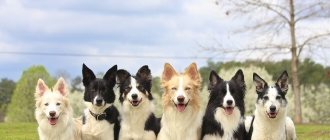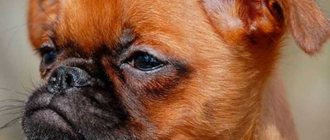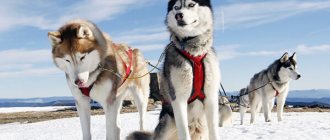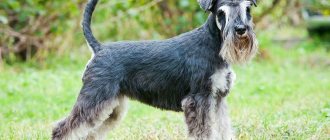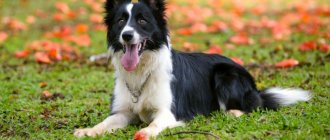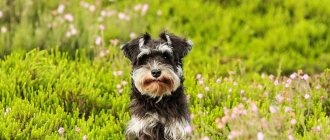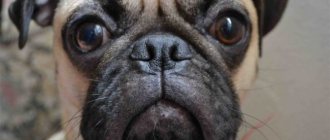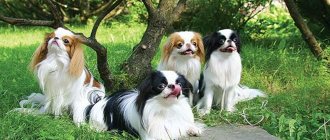What is the correct name of the breed? Is this a rare breed of dog? How much does an Aussie cost? What height and weight are they? Short or long tail - which is correct? How to understand colors? I want a puppy with blue eyes. Is this possible? How do they treat cats and other animals? Will Aussie make friends with my cat? Do Aussies love children? How is their health? We live in an apartment. Will Aussies be crowded there? We live in a house. Can Aussies live outside? We choose between a border collie and an aussie. What do you advise? We want the whole family to come and visit you. Can?
Border Collie Personality
Dogs of this breed are affectionate and cheerful. Border collies can be both playful and attentive. They love to follow everything that happens around them, are endlessly devoted to their owners and at the same time can make decisions themselves if necessary. Brown or other colored Border Collies are great with children, so they can be kept in families with small children. The advantage is that the child’s energy is enough to fulfill the animal’s activity needs. With animals everything is different, there will be no aggression, but the dog will want to dominate, and not everyone may like this.
When describing the intelligence of the border collie, it is important to know that it is so high that it helps the dogs hide traces of “crimes”. They will not deliberately cause mischief, but if this happens, they will try to “clean up after themselves” in order to avoid the wrath of the owner. It is recommended to have a pet for people who lead an active lifestyle and often travel outside the city, because the dog needs to be regularly “loaded” with work. The animal is polite towards strangers, but will remain distant. However, with any aggression towards the owner, everything will change.
Pros and cons of the border collie
Like other breeds, these dogs have advantages and disadvantages. Before choosing the Border Collie breed, it is recommended to get to know them. Positive qualities include:
- independence and obedience;
- high level of intelligence;
- ease of training;
- lack of aggression;
- good health;
- lack of jealousy towards children;
- love active activities;
- long period of life.
Those who are less familiar with this breed are interested in how much a border collie costs. On average, the price can range from $46 to 1500, it all depends on the pedigree of the parents. The negative aspects include:
- can manipulate household members;
- do not tolerate loneliness well;
- prone to escape;
- if handled incorrectly, they can become aggressive;
- require movement and mental stress;
- the shepherd's instinct may awaken.
Border Collie colors
The vast majority of standard representatives of the breed have black and white coats. His gene is the most active and puppies can be born after mating dogs of different colors. Marbled or other colored Border Collies may have tan markings. In addition to this, there are other types:
- blue is obtained by combining a black dominant and an allele;
- tricolor dogs come in many variations;
- brown individuals are heterozygous for all colors;
- red color can range from cream to sable;
- The marbled tint often appears in puppies.
Border Collie Care
Caring for the animal should not cause problems; dog experts recommend paying special attention to the fur. Among the main postulates are the following:
- Wool
. Brush with a wire brush once every two weeks. Before doing this, the wool must be moistened so as not to tear out tufts. Bathe your Border Collie in a foamy shampoo, such as Shampoo Border Collie, and then apply conditioner. for example, IDEAL. Dry with a towel and then comb. - Paws
. It is recommended to trim the claws once a month; special attention should be paid to the fifth toe, which is not sharpened when walking. After a walk, the paws are washed or wiped with a damp cloth. - Ears
. Once a week, the inside is cleaned to remove excess wax and inspect for the presence of parasites. - Eyes
. A black or other colored Border Collie needs to be prevented from getting dirty by wiping it with cotton pads soaked in green tea. - Teeth
. They are cleared of stone by eating bones, and antiseptic ointments can be used for gums. - Protection from parasites
. Thick fur and walks in nature lead to the appearance of fleas and ticks. After a walk, it is important to conduct an inspection and use different aerosols to prevent infection.
Border Collie nutrition
Dogs are unpretentious eaters. A Border Collie, red or any other shade, needs fresh food. An adult is fed three times a day. Food must be high in calories, as the breed is active. It is important to provide open access to fresh water. Dog handlers allow adding premium dry food to the diet, for example: NOW FRESH, Acana or Orijen. Main list of dishes for border collies:
- lean animal and poultry meat;
- rice and buckwheat without spices;
- raw seasonal vegetables;
- sea fish;
- skim cheese;
- eggs;
- dairy products;
- offal.
The following foods are prohibited for border collies:
- bread;
- sweets;
- smoked meats;
- fat meat;
- legumes;
- cabbage.
Border Collie Grooming
Similar procedures are carried out when the hair prevents the dog from moving comfortably. You can contact a specialist or do everything yourself. Hairdressing scissors are suitable for cutting. The Border Collie is a smooth-haired breed, the procedure consists of the following steps:
- The hair is combed downwards.
- Using scissors, remove excess length to a satisfactory result.
- The contour is processed with a thinning tool.
- They do the same on the paws. From below, the wool is cut to the level of the pads.
Border Collie Toys
For playful dogs, it would be a good idea to purchase small items that can distract them from the furniture and prevent them from getting bored when the owner is not around. A short-haired border collie will appreciate the following toys:
- training ring;
- rubber ball;
- rope with knots at the edges;
- animals with different sounds;
- ring with rope;
- polymer bones.
Border Collie training
This breed is one of the most capable of learning. A high level of obedience will help you repeat commands clearly. The Border Collie accepts training as part of life and will appreciate your time. The main method of encouragement is affection and goodies. It is recommended to start training when Border Collie puppies reach six months of age. It is important to understand that all commands will be carried out flawlessly only at an older age. It is important to combine training with games so that the dog does not get bored. Favorite activities:
- jumping over obstacles;
- running for a stick;
- games with a tennis ball.
How to toilet train a border collie?
To avoid the appearance of an unpleasant odor in the room, it is important to teach your dog hygiene in a timely manner. You can toilet train a puppy by knowing the following components:
- Supervision
. If the border collie has free access to the street, problems may arise with this, because there are no restrictions there. However, in any case, you need to observe and as soon as movement is noticed in one place, this is a sign to direct it to the designated place. - Limitation
. The puppy should be left alone in a confined space or in a playpen. It would be better if there was a toilet there. - Consistency
. Training must be continuous until the bitter end. You need to take your small dog to the toilet at a certain time. It is important to do this in the morning, after eating and active play. - Praise
. After being rewarded for doing the right thing, the Border Collie puppy understands that by doing it again, he will receive affection or another reward.
Keeping a border collie in an apartment
The best place for dogs of this breed to live is a private house with a large yard where they can run around all day. Border collies can also be kept in an apartment, but in this case they need to be given daily walks for two hours, preferably in the morning and evening. They must have their own place to sleep and rest, and the dog must see the surrounding space from it.
Origin story
It’s hard to imagine, but the homeland of these extraordinary dogs, which can sometimes be found on Russian streets, is distant Scotland. It was to the Shetland Islands several hundred years ago that the distant ancestors of these dogs arrived on ships of settlers from the mainland. These animals were used to help shepherds, guard and walk animals. The fertile Scottish vegetation and spacious mountain valleys have become ideal pasture for raising small livestock: sheep and goats.
For example, with Spitz dogs, from which these dogs received a soft and fluffy coat, as well as a variety of colors. Over time, these shepherd dogs began to be deliberately crossed with representatives of other breeds in order to inherit certain external or physical qualities. According to some sources, the following dog breeds participated in the formation of the Sheltie breed: border collies, King Charles spaniels, Schipperkes, Icelandic and Greenlandic shepherd dogs.
Initially, the Sheltie's ancestors were used exclusively for herding - their small size allowed these dogs to freely and quickly manage medium-sized herds of sheep. Shelties not only monitored the stray sheep, but also helped drive the entire herd at the end of the working day from the grazing area to the paddock, and loudly barked to inform the shepherds about the arrival of the herd.
Shelties were the ideal herding dog for the Scottish lands - they had a light but strong body and strong legs that allowed them to move quickly through even the most difficult terrain. In addition, the long hair of these dogs allowed them to successfully withstand the humid Scottish climate and significant temperature changes.
The turning point in the formation of this shepherd breed was the beginning of the 19th century, when larger and stronger breeds of sheep were developed through selective breeding. The new breeds found a real sensation among British farmers: these individuals were more hardy, larger and healthier. However, this had an extremely negative impact on the spread of Shetland Sheepdog dogs.
The fact is that the new individuals were more wayward and strong than the previous breeds, and therefore many sheep simply refused to obey and submit to the little Sheltie. This led to the almost complete extinction of the Sheltie in Scotland. Very soon, instead of these dogs, the herds began to be guarded by stronger and larger dogs - specially bred shepherd dogs.
It was British breeders who began actively restoring and developing Shetland Sheepdogs. The first club of this breed was founded back in 1908 by British breeder James Loggie in the capital of the Shetland Islands, Lerwick. Loggie not only opened a Sheltie breed club, but also sought to standardize this breed.
According to the original idea, these dogs should have been called “Scottish collies”, but this name was negatively criticized by owners of purebred collies. In the future, these dogs were given a different name - “Shetland Sheepdogs”, which is still used today.
By the beginning of the 20th century, the first Sheltie specimens came to North America, where they became widespread among American dog handlers and breeders of decorative dog breeds. Unfortunately, identity and official status came to these dogs only after World War II (1948). Prior to this, not a single American or British canine association dared to give these dogs official status because of the too great external similarity of these dogs with the collie breed. Despite the late recognition, the standard of these dogs was finally formed by 1914.
These dogs appeared on Russian territory only in the 90s of the 20th century. Despite the unusual exterior and attractive appearance, Shelties did not gain much popularity, as did Collies.
Key facts
The Collie is a beautiful aristocratic dog, despite its working origins. The description of the collie breed says that the dog is very smart and quick-witted.
The Scottish Sheepdog has a wonderful friendly and balanced character. Like most herding dogs, she gets along well with children and animals and becomes an attentive nanny for them. For an adult, a collie will be a good companion.
This breed is highly trainable, but will not work for protection. Sports are more suitable for her.
The characteristics of the collie breed emphasize that they are very healthy animals, real long-livers. However, there are some breed-specific diseases. The lifespan of a collie is on average 13 years.
These animals are unpretentious when it comes to food, which cannot be said about caring for their fur. To keep a collie looking beautiful, you need to brush and wash it regularly, which is not the easiest thing. There is a close relative of the long-haired Scottish Collie - the short-haired variety, but they are not common in our country.
History of the origin of the species
Collies are long-haired herding dogs that have been serving people since the 14th century (the first documents refer to it). The poet Chaucer was the first to record these animals in his works, and after that the breed was described in many books: “History of Quadrupeds”, “English Dogs” and “Encyclopedia Britannica of Dogs”.
The name of the breed has two origins. According to the first version, “Collie” is a transcription of the English word “coaly”, which is translated as “coal”. This is exactly the color that the first representatives of Scottish Shepherds had. Second version: “colleys” is the breed of sheep that these dogs herded.
It is not known exactly who the ancestors of shepherd dogs were. There are two opposing opinions, according to which Collies were either brought by Roman legionnaires, or they already existed in Scottish lands. The shepherds were busy driving the herd into one heap. They did not need to protect the sheep from the wolves, because they had long since been exterminated. This saved the Scottish Shepherds from aggression.
The popularization of the breed began in 1860, when Queen Victoria noticed the Collie and transported several individuals to London. The breed was divided into several types: Border collies remained shepherds. In 1881 the standard was published. Active breeding work began to breed colored individuals, and not just black ones. Dogs with thick and long coats were selected.
A new surge in popularity occurred in 1940, when Eric Knight released his novel “Lassie Comes Home,” in which the main character is the Collie dog. In 1943, the first film was released, and numerous films and sequel series were made in which Lassie showed her devotion.
Feedback from Australian Shepherd owners
Reviews taken from the Australian Shepherd forum:
Ivan, Saratov
Sociable dog. Even more. Genetically positive for humans. Active and easy to train.
Vladimir, St. Petersburg
The dog is truly universal. Helps me with farming, good as a companion. She is friends with all members of my family and is completely devoted to us. He always tries to please me, his owner. A dog with a healthy psyche, active and sociable. I recommend to everyone.
Sergey, Rostov-on-Don
I am the owner of a 3 year old male Aussie. I can say that the dog's intelligence is high. She is moderately active. He loves to walk in the company of children and does not offend them. She is completely and completely devoted to our family members. It barks at strangers and displays its anger, but does not bite 100%. Good dog! The only thing is that I don’t recommend getting an Australian for people who are allergic to wool.
Reds
The color has several names, differing by country and personal preference of dog owners:
- red;
- auburn,
- brown;
- hepatic;
- chocolate.
The colored colors are adjacent to the white areas of the fur. As for red, this is a symbolic name that can mean either a burnt sienna tone or a rich, warm chocolate shade. These collies have amber eyes, sometimes light green. The nose is brown or liver-colored.
There is no “right” or “wrong” color for this color group. During the molting period, the color of the coat lightens somewhat, but the true red tint remains on the dog’s face, hips, sides, and back.
By its nature, the gene responsible for the formation of red pigment is recessive. Therefore, chocolate and red borders appear only if both the father and mother are its carriers.
Photos of chocolate borders:


